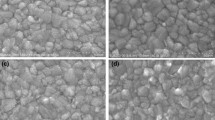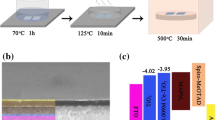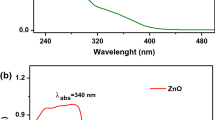Abstract
Despite demonstrating remarkable power conversion efficiencies (PCEs), perovskite solar cells (PSCs) have not yet achieved their full potential. In particular, the interfaces between the perovskite and charge transport layers account for the vast majority of the recombination losses. Interfacial contact and band alignment between the low-temperature-processed TiO2 electron transport layer (ETL) and the perovskite are essential to minimize nonradiative recombination losses. In this study, a CeOx interlayer is employed to modify the perovskite/TiO2 interface, and the charge transport properties of the devices are investigated. The bilayer-structured TiO2/CeOx ETL leads to the modification of the interface energetics, resulting in improved electron extraction and reduced nonradiative recombination in the PSCs. Devices based on TiO2/CeOx ETL exhibit a high open-circuit voltage (Voc) of 1.13 V and an enhanced PCE of more than 20% as compared with Voc of 1.08 V and a PCE of approximately 18% for TiO2-based devices. Moreover, PSCs based on TiO2/CeOx ETL maintain over 88% of their initial PCEs after light illumination for 300 min, whereas PSCs based on TiO2 ETL almost failed. This study provides an efficient strategy to enhance the PCE and stability of PSCs based on a low-temperature-processed TiO2 ETL.

摘要
尽管已经获得了很高的能量转换效率, 但由于非辐射复合损失, 钙钛矿太阳电池的潜力仍未完全释放. 钙钛矿层和电荷传输层之间的界面是发生复合损耗最多的地方. 对于低温制备的TiO2电子传输层, 其与钙钛矿层之间的界面接触和能带对准对于非辐射复合损耗的减少来说至关重要. 在这项研究中, 我们利用CeOx中间层修饰钙钛矿/TiO2界面, 并研究了器件的电荷传输性能. 双层结构的TiO2/CeOx电子传输层改善了界面接触和能级匹配, 提高了电子转移, 抑制了界面复合. 基于TiO2/CeOx电子传输层的器件表现出1.13 V的高开路电压和超过20%的光电转换效率, 而基于TiO2电子传输层器件的开路电压仅为1.08 V, 转换效率约为18%. 此外, 基于TiO2/CeOx电子传输层的钙钛矿器件在300 min光照后仍能保持初始效率的88%, 而基于TiO2电子传输层的器件几乎失效. 这项研究为基于低温TiO2电子传输层的钙钛矿太阳电池提供了一种增强转换效率和光稳定性的有效策略.
Similar content being viewed by others
References
Kim JY, Lee JW, Jung HS, et al. High-efficiency perovskite solar cells. Chem Rev, 2020, 120: 7867–7918
Jena AK, Kulkarni A, Miyasaka T. Halide perovskite photovoltaics: Background, status, and future prospects. Chem Rev, 2019, 119: 3036–3103
Shi X, Chen J, Wu Y, et al. Efficient formamidinium-based planar perovskite solar cells fabricated through a CaI2-PbI2 precursor. ACS Sustain Chem Eng, 2020, 8: 4267–4275
Ma S, Cai M, Cheng T, et al. Two-dimensional organic-inorganic hybrid perovskite: From material properties to device applications. Sci China Mater, 2018, 61: 1257–1277
Shi P, Ding Y, Liu C, et al. Advanced partial nucleation for singlephase FA0.92MA0.08PbI3-based high-efficiency perovskite solar cells. Sci China Mater, 2019, 62: 1846–1856
https://www.Nrel.Gov/pv/assets/pdfs/best-research-cell-efficiencies20200925.Pdf
Tress W. Perovskite solar cells on the way to their radiative efficiency limit—insights into a success story of high open-circuit voltage and low recombination. Adv Energy Mater, 2017, 7: 1602358
Stolterfoht M, Wolff CM, Márquez JA, et al. Visualization and suppression of interfacial recombination for high-efficiency large-area pin perovskite solar cells. Nat Energy, 2018, 3: 847–854
Stolterfoht M, Caprioglio P, Wolff CM, et al. The impact of energy alignment and interfacial recombination on the internal and external open-circuit voltage of perovskite solar cells. Energy Environ Sci, 2019, 12: 2778–2788
Wolff CM, Caprioglio P, Stolterfoht M, et al. Nonradiative recombination in perovskite solar cells: The role of interfaces. Adv Mater, 2019, 31: 1902762
Rajagopal A, Yao K, Jen AKY. Toward perovskite solar cell commercialization: A perspective and research roadmap based on interfacial engineering. Adv Mater, 2018, 30: 1800455
Shi X, Chen R, Jiang T, et al. Regulation of interfacial charge transfer and recombination for efficient planar perovskite solar cells. Sol RRL, 2020, 4: 1900198
Chen J, Park NG. Materials and methods for interface engineering toward stable and efficient perovskite solar cells. ACS Energy Lett, 2020, 5: 2742–2786
Choi K, Choi H, Min J, et al. A short review on interface engineering of perovskite solar cells: A self-assembled monolayer and its roles. Sol RRL, 2020, 4: 1900251
Qiu J, Yang S. Material and interface engineering for high-performance perovskite solar cells: A personal journey and perspective. Chem Rec, 2020, 20: 209–229
Mingorance A, Xie H, Kim H-, et al. Interfacial engineering of metal oxides for highly stable halide perovskite solar cells. Adv Mater Interfaces, 2018, 5: 1800367
Wang J, Liu Y, Chen X, et al. Functional metal oxides in perovskite solar cells. ChemPhysChem, 2019, 20: 2580–2586
Shin SS, Lee SJ, Seok SI. Metal oxide charge transport layers for efficient and stable perovskite solar cells. Adv Funct Mater, 2019, 29: 1900455
Haque MA, Sheikh AD, Guan X, et al. Metal oxides as efficient charge transporters in perovskite solar cells. Adv Energy Mater, 2017, 7: 1602803
Zhou Y, Li X, Lin H. To be higher and stronger—metal oxide electron transport materials for perovskite solar cells. Small, 2020, 16: 1902579
Xu X, Zhang H, Shi J, et al. Highly efficient planar perovskite solar cells with a TiO2/ZnO electron transport bilayer. J Mater Chem A, 2015, 3: 19288–19293
Xu J, Fang M, Chen J, et al. ZnO-assisted growth of CH3NH3-PbI3−xClx. film and efficient planar perovskite solar cells with a TiO2/ZnO/C60 electron transport trilayer. ACS Appl Mater Interfaces, 2018, 10: 20578–20590
Zhang P, Wu J, Zhang T, et al. Perovskite solar cells with ZnO electron-transporting materials. Adv Mater, 2018, 30: 1703737
Li N, Yan J, Ai Y, et al. A low-temperature TiO2/SnO2 electron transport layer for high-performance planar perovskite solar cells. Sci China Mater, 2020, 63: 207–215
Tavakoli MM, Yadav P, Tavakoli R, et al. Surface engineering of TiO2 ETL for highly efficient and hysteresis-less planar perovskite solar cell (21.4%) with enhanced open-circuit voltage and stability. Adv Energy Mater, 2018, 8: 1800794
Leijtens T, Eperon GE, Pathak S, et al. Overcoming ultraviolet light instability of sensitized TiO2 with meso-superstructured organometal tri-halide perovskite solar cells. Nat Commun, 2013, 4: 2885
Tan H, Jain A, Voznyy O, et al. Efficient and stable solution-processed planar perovskite solar cells via contact passivation. Science, 2017, 355: 722–726
Wang X, Deng LL, Wang LY, et al. Cerium oxide standing out as an electron transport layer for efficient and stable perovskite solar cells processed at low temperature. J Mater Chem A, 2017, 5: 1706–1712
Shi X, Wu Y, Chen J, et al. Thermally stable perovskite solar cells with efficiency over 21% via a bifunctional additive. J Mater Chem A, 2020, 8: 7205–7213
Zhou Y, Perket JM, Zhou J. Growth of Pt nanoparticles on reducible CeO2 (111) thin films: Effect of nanostructures and redox properties of ceria. J Phys Chem C, 2010, 114: 11853–11860
Hu T, Xiao S, Yang H, et al. Cerium oxide as an efficient electron extraction layer for p-i-n structured perovskite solar cells. Chem Commun, 2018, 54: 471–474
Artiglia L, Agnoli S. Cerium oxide nanostructures on titania: Effect of the structure and stoichiometry on the reactivity toward ethanol oxidation. J Phys Chem C, 2018, 122: 20809–20816
Luo S, Nguyen-Phan TD, Johnston-Peck AC, et al. Hierarchical heterogeneity at the CeOx-TiO2 interface: Electronic and geometric structural influence on the photocatalytic activity of oxide on oxide nanostructures. J Phys Chem C, 2015, 119: 2669–2679
Artiglia L, Agnoli S, Paganini MC, et al. TiO2@CeOx core-shell nanoparticles as artificial enzymes with peroxidase-like activity. ACS Appl Mater Interfaces, 2014, 6: 20130–20136
Klasen A, Baumli P, Sheng Q, et al. Removal of surface oxygen vacancies increases conductance through TiO2 thin films for perovskite solar cells. J Phys Chem C, 2019, 123: 13458–13466
Wang B, Zhang M, Cui X, et al. Unconventional route to oxygen-vacancy-enabled highly efficient electron extraction and transport in perovskite solar cells. Angew Chem Int Ed, 2020, 59: 1611–1618
Shi X, Ding Y, Zhou S, et al. Enhanced interfacial binding and electron extraction using boron-doped TiO2 for highly efficient hysteresis-free perovskite solar cells. Adv Sci, 2019, 6: 1901213
Caprioglio P, Stolterfoht M, Wolff CM, et al. On the relation between the open-circuit voltage and quasi-Fermi level splitting in efficient perovskite solar cells. Adv Energy Mater, 2019, 9: 1901631
Qi B, Wang J. Open-circuit voltage in organic solar cells. J Mater Chem, 2012, 22: 24315–24325
You J, Yang YM, Hong Z, et al. Moisture assisted perovskite film growth for high performance solar cells. Appl Phys Lett, 2014, 105: 183902
Shi J, Dong J, Lv S, et al. Hole-conductor-free perovskite organic lead iodide heterojunction thin-film solar cells: High efficiency and junction property. Appl Phys Lett, 2014, 104: 063901
Koster LJA, Mihailetchi VD, Ramaker R, et al. Light intensity dependence of open-circuit voltage of polymer:fullerene solar cells. Appl Phys Lett, 2005, 86: 123509
Bertoluzzi L, Sanchez RS, Liu L, et al. Cooperative kinetics of depolarization in CH3NH3PbI3 perovskite solar cells. Energy Environ Sci, 2015, 8: 910–915
Chen TP, Lin CW, Li SS, et al. Self-assembly atomic stacking transport layer of 2D layered titania for perovskite solar cells with extended UV stability. Adv Energy Mater, 2018, 8: 1701722
Li Y, Cooper JK, Liu W, et al. Defective TiO2 with high photoconductive gain for efficient and stable planar heterojunction perovskite solar cells. Nat Commun, 2016, 7: 12446
Acknowledgements
This work was supported by the National Key Research and Development Program of China (2018YFB1500101), the 111 Project (B16016), the National Natural Science Foundation of China (U1705256, 51702096 and 61904053), and the Fundamental Research Funds for the Central Universities (2019MS026, 2019MS027 and 2020MS080).
Author information
Authors and Affiliations
Contributions
Author contributions Dai S and Cai M supervised the project. Shi X conceived the original concept, designed the experiments, and wrote the manuscript. Shi X, Tao Y, and Li Z fabricated the devices and conducted the characterization and analysis with support from Peng H. Zhang Z provided helpful discussion during the revision process. Cai M and Liu X revised the manuscript, and all authors contributed to the general discussion.
Corresponding authors
Ethics declarations
Conflict of interest The authors declare no conflict of interest.
Additional information
Xiaoqiang Shi obtained his BS and PhD degrees from North China Electric Power University in 2015 and 2020, respectively. He is currently a postdoctoral researcher at the College of Physics and Optoelectronic Engineering, Shenzhen University. His research interests include perovskite solar cells and antimony chalcogenide solar cells.
Molang Cai obtained her PhD degree from the Institute of Plasma Physics, Chinese Academy of Sciences in 2013. From 2013 to 2018, she successively worked as postdoctoral researcher at Queensland University of Technology and the National Institute of Materials Science, studying on efficient perovskite solar cells. In 2018, she joined North China Electric Power University as a professor. Her research interests mainly focus on efficient perovskite solar cells and in-situ measurement of photovoltaic materials and devices.
Songyuan Dai obtained his BS degree from Anhui Normal University in 1987, and MS and PhD degrees from the Institute of Plasma Physics, Chinese Academy of Sciences in 1991 and 2001, respectively. In 2012, he joined North China Electric Power University as a full professor. His research interests include dye-sensitized solar cells, quantum-dot solar cells and perovskite solar cells.
Rights and permissions
About this article
Cite this article
Shi, X., Tao, Y., Li, Z. et al. Photo-stable perovskite solar cells with reduced interfacial recombination losses using a CeOx interlayer. Sci. China Mater. 64, 1858–1867 (2021). https://doi.org/10.1007/s40843-020-1625-2
Received:
Accepted:
Published:
Issue Date:
DOI: https://doi.org/10.1007/s40843-020-1625-2




